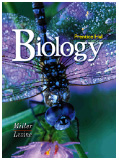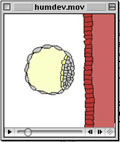BIOLOGY
by Miller & Levine
[complete Table of Contents]

|
Use the pull-down menu to jump to any of the Book's 40 Chapters: |
![]() Chapter 39
Chapter 39 ![]()
ENDOCRINE AND REPRODUCTIVE SYSTEMS
In this chapter, students will read about the structure and function of the endocrine and reproductive systems of the human body. They will also read about fertilization and how a human fetus develops. The links below lead to additional resources to help you with this chapter. These include Hot Links to Web sites related to the topics in this chapter, the Take It to the Net activities referred to in your textbook, a Self-Test you can use to test your knowledge of this chapter, and Teaching Links that instructors may find useful for their students.
| Hot Links | Take it to the Net |
| Chapter Self-Test | Teaching Links |
What are Web Codes? |
Web
Codes for Chapter 39: |
![]()
Section 39-1: The Endocrine System
![]() The endocrine system
is made up of glands that release their products into the bloodstream.
The endocrine system
is made up of glands that release their products into the bloodstream.
 These products broadcast messages throughout
the body.
These products broadcast messages throughout
the body.
 Like most systems of the body, the endocrine
system is regulated by feedback mechanisms that function to maintain homeostasis.
Like most systems of the body, the endocrine
system is regulated by feedback mechanisms that function to maintain homeostasis.
Section 39-2: Human Endocrine Glands
![]() The pituitary
gland secretes nine hormones that directly regulate many body functions
and control the actions of several other endocrine glands.
The pituitary
gland secretes nine hormones that directly regulate many body functions
and control the actions of several other endocrine glands.
![]() The hypothalamus
controls the secretions of the pituitary gland.
The hypothalamus
controls the secretions of the pituitary gland.
![]() The thyroid gland
has the major role in regulating the body's metabolism.
The thyroid gland
has the major role in regulating the body's metabolism.
![]() Hormones from
the thyroid gland and the parathyroid glands maintain homeostasis in blood
calcium levels.
Hormones from
the thyroid gland and the parathyroid glands maintain homeostasis in blood
calcium levels.
![]() The adrenal glands
help the body prepare for and deal with stress.
The adrenal glands
help the body prepare for and deal with stress.
![]() Insulin and glucagon
released from the pancreas help to keep the level of glucose in the blood
stable.
Insulin and glucagon
released from the pancreas help to keep the level of glucose in the blood
stable.
![]() The gonads serve
two important functions: the production of gametes and the secretion of
sex hormones.
The gonads serve
two important functions: the production of gametes and the secretion of
sex hormones.
Section 39-3: The Reproductive System
![]() The main structures
of the male reproductive system are the testes, the epididymis, the vas
deferens, the urethra, and the penis. These structures work together to
produce and deliver sperm.
The main structures
of the male reproductive system are the testes, the epididymis, the vas
deferens, the urethra, and the penis. These structures work together to
produce and deliver sperm.
![]() The main structures
of the female reproductive system are the ovaries, the Fallopian tubes,
the uterus, and the vagina. In addition to producing eggs, the female
reproductive system prepares the female's body to nourish a developing
embryo.
The main structures
of the female reproductive system are the ovaries, the Fallopian tubes,
the uterus, and the vagina. In addition to producing eggs, the female
reproductive system prepares the female's body to nourish a developing
embryo.
![]() The menstrual
cycle has four phases: follicular phase, ovulation, luteal phase, and
menstruation.
The menstrual
cycle has four phases: follicular phase, ovulation, luteal phase, and
menstruation.
Section 39-4: Fertilization and Development
![]() The process of
a sperm joining with an egg is called fertilization.
The process of
a sperm joining with an egg is called fertilization.
![]() The placenta is
the embryo's organ of respiration.
The placenta is
the embryo's organ of respiration.
Additional Resources:
Click for a Quicktime animation of human embryonic development (from the University of Pennsylvania)
E. E. Just was one of the great pioneers of developmental biology. Click on the stamp honoring him for more information about his scientific career
Centers
for Disease Control
The CDC's web page on STDs (sexually-transmitted diseases)
and their prevention.
Slides
of Human Development
(An excellent teaching resource - from the University of
Virginia)
The
Endocrine System
An overview of the system - from a course at Clermont College.
Pituitary
Hormones
Detailed information on the biochemistry and function of
pituitary hormones. From an on-line biology textbook.
The
Thyroid Society
An organization providing information on thyroid function
and diseases of the thyroid.
Steroid
Hormones
Detailed biochemistry and functional information (from
Indiana State University)

